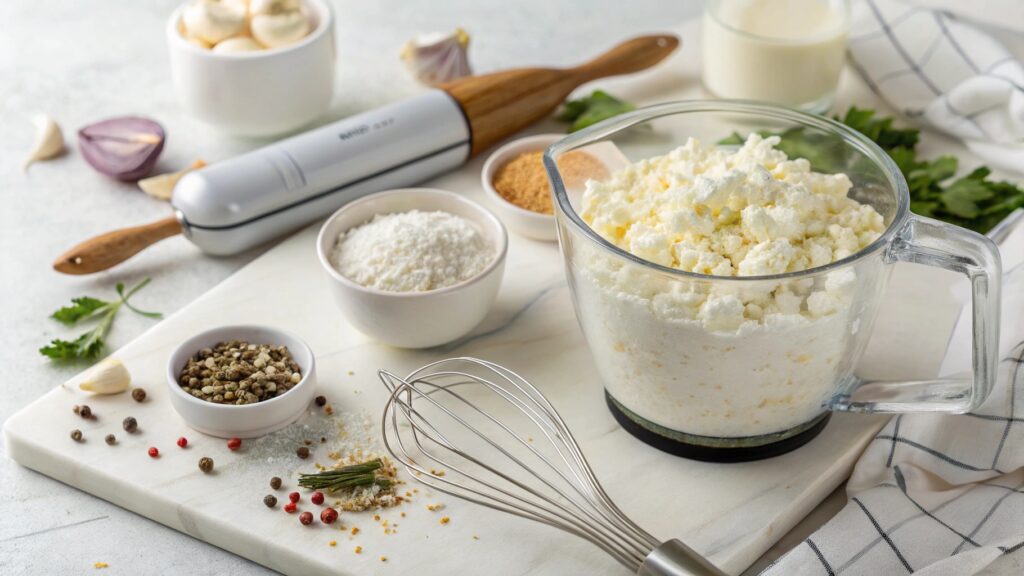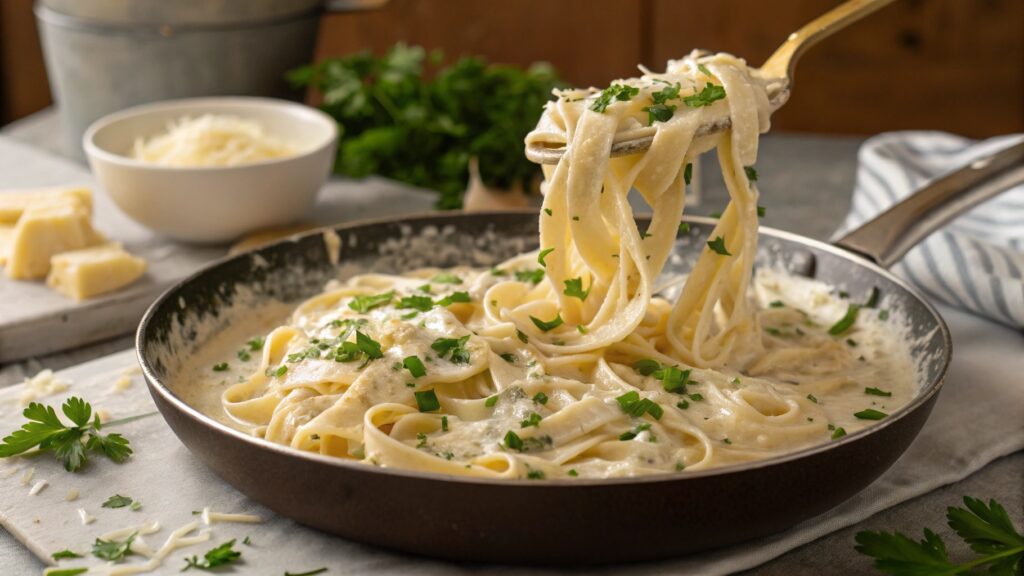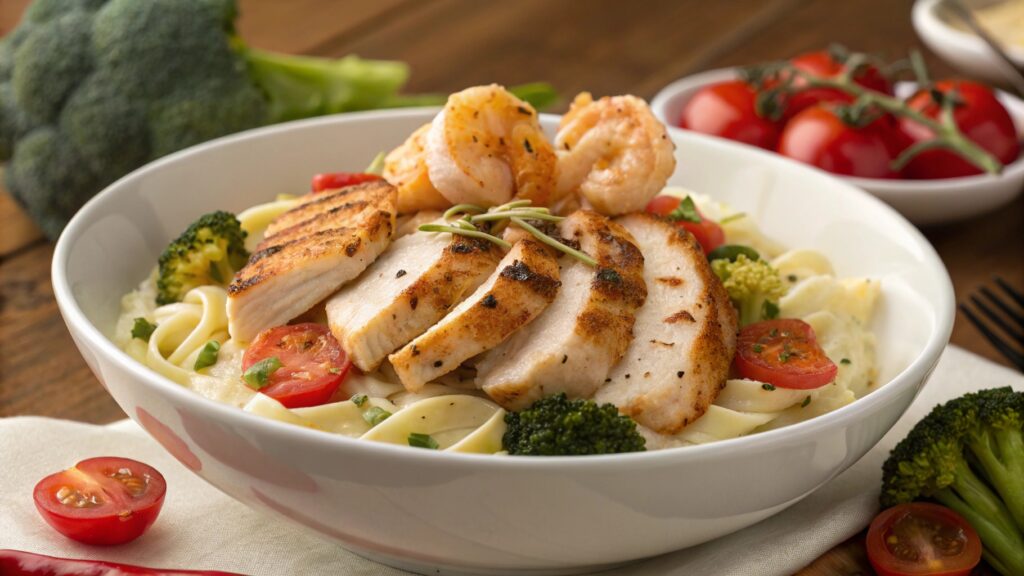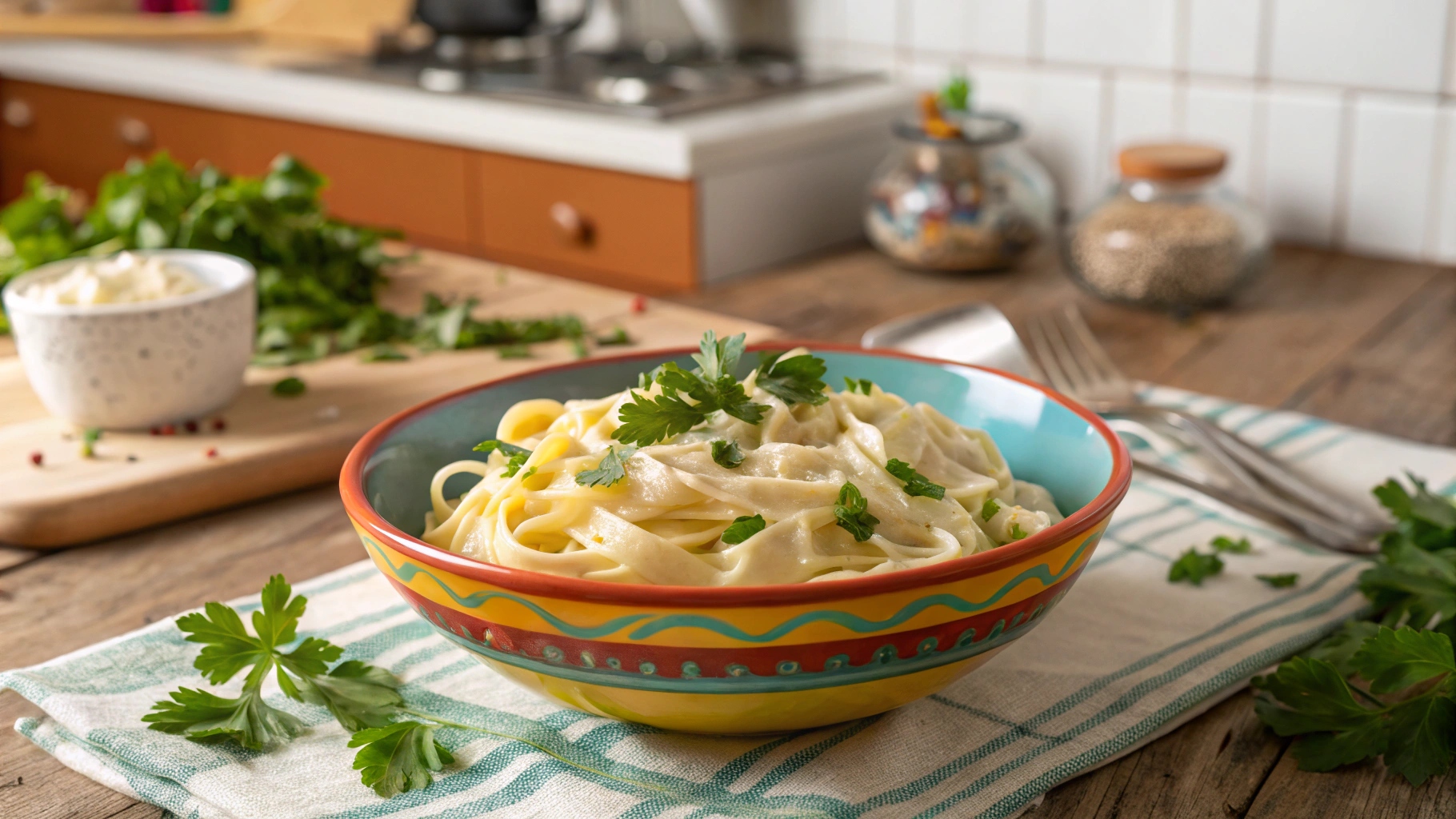Table of Contents
Cottage cheese is a powerhouse ingredient that’s often overlooked in pasta recipes. In this guide, we’ll show you how to transform this humble dairy product into a creamy, rich Alfredo sauce that’s healthier and equally satisfying as the classic version. Whether you’re trying to cut calories, pack in more protein, or just love experimenting in the kitchen, cottage cheese Alfredo is a must-try dish.
From understanding its unique benefits to learning how to prepare it step-by-step, this article covers everything you need. Plus, we’ll explore recipe variations, storage tips, and answer your burning questions. Ready to dive in? Let’s start by understanding what makes cottage cheese Alfredo so special.
What is Cottage Cheese Alfredo?
Cottage cheese Alfredo is a lighter, protein-packed twist on the classic Alfredo sauce. Traditional Alfredo is made with heavy cream, butter, and Parmesan cheese, creating a rich and indulgent dish. Cottage cheese, on the other hand, offers a healthier alternative without skimping on flavor or creaminess.
What Makes Cottage Cheese Alfredo Unique?
The magic of cottage cheese lies in its texture and versatility. When blended, it transforms into a smooth, velvety sauce that rivals cream-based recipes. It’s also a nutrient-dense option, loaded with protein, calcium, and essential vitamins.
Unlike traditional Alfredo, which can be heavy and calorie-dense, cottage cheese Alfredo is light yet satisfying. It’s perfect for those looking to enjoy comfort food without feeling weighed down afterward.
Origins and Health Benefits of Cottage Cheese Alfredo
While Alfredo sauce traces its roots to Italy, the cottage cheese variation is a modern adaptation driven by health-conscious cooks. With growing interest in low-fat and high-protein diets, cottage cheese has found its place in everything from pancakes to sauces.
One of the biggest benefits? Cottage cheese contains far less fat than heavy cream, making it ideal for anyone watching their calorie intake. It’s also an excellent source of casein protein, which digests slowly, keeping you fuller for longer.
Cottage cheese Alfredo isn’t just a healthier choice—it’s a versatile base for adding your favorite flavors. From garlic and herbs to a sprinkle of nutmeg, the possibilities are endless!
Ingredients Needed for Cottage Cheese Alfredo
To make cottage cheese Alfredo, you’ll need a handful of simple, wholesome ingredients. Each plays a crucial role in achieving that signature creamy texture and savory flavor.
Key Ingredients: Cottage Cheese and Substitutes
The star of this dish is, of course, cottage cheese. Opt for full-fat or low-fat varieties depending on your preference. Full-fat cottage cheese delivers a richer taste, while low-fat versions keep the dish lighter.
If cottage cheese isn’t available, ricotta cheese or silken tofu can be used as substitutes. These alternatives mimic the creamy texture while offering similar nutritional benefits.
Enhancing the Flavor with Herbs, Garlic, and Cheese
Classic Alfredo sauce is known for its robust flavor, and cottage cheese Alfredo is no different. Fresh garlic and a sprinkle of onion powder elevate the dish’s taste profile. Adding grated Parmesan cheese gives the sauce a nutty, umami depth that pairs perfectly with pasta.
Herbs like parsley, basil, or oregano add a touch of freshness. For a spicier twist, a pinch of red pepper flakes works wonders.
Choosing the Right Pasta for Alfredo
While fettuccine is the traditional choice for Alfredo sauce, cottage cheese Alfredo is versatile enough to pair with almost any pasta. Spaghetti, penne, or even whole-grain options are excellent choices. For a low-carb variation, consider zucchini noodles or spaghetti squash.
Step-by-Step Recipe for Cottage Cheese Alfredo
Making cottage cheese Alfredo is surprisingly quick and easy. This step-by-step guide ensures you get creamy, flavorful sauce every time.
Preparing the Cottage Cheese Alfredo Sauce

- Blend for Creaminess: Start by blending cottage cheese with a splash of milk until smooth. This step removes the natural curds, creating a silky base for your sauce.
- Sauté Garlic: Heat olive oil or butter in a pan. Add minced garlic and cook until fragrant, about 1-2 minutes.
- Combine and Simmer: Pour the blended cottage cheese into the pan. Stir in Parmesan cheese, salt, and pepper. Simmer for 5 minutes, allowing the flavors to meld.
Tips for Blending Cottage Cheese for Creaminess
A high-powered blender or food processor works best for achieving a smooth texture. If you prefer a chunkier sauce, pulse the blender instead of pureeing.
Adding a tablespoon of cornstarch or flour can help thicken the sauce if it’s too runny. However, don’t skip simmering—it naturally thickens the mixture.
Cooking Pasta Perfectly for Alfredo Dishes
Cook your pasta according to the package instructions, ensuring it’s al dente. Drain the pasta but reserve ½ cup of the starchy cooking water. This can be added to the Alfredo sauce if it needs thinning.
Combining Pasta with Alfredo Sauce for Best Results

Once the sauce is ready, toss it with the pasta while it’s still hot. The heat helps the sauce cling to every strand, creating a restaurant-quality dish. Garnish with freshly chopped parsley and extra Parmesan before serving.
For more easy and healthy pasta recipes, explore this guide to Crockpot Spaghetti. It’s a time-saving option packed with flavor!
Variations and Add-Ons for Cottage Cheese Alfredo
One of the best things about cottage cheese Alfredo is its versatility. From proteins to vegetables, you can tweak the recipe to suit your taste or dietary needs.
Protein Options: Chicken, Shrimp, or Tofu

Adding protein to cottage cheese Alfredo transforms it into a filling main course. Grilled or shredded chicken is a classic choice, adding a hearty element to the creamy sauce.
For seafood lovers, sautéed shrimp pairs beautifully with the tangy richness of the Alfredo sauce. Vegetarians can opt for pan-fried tofu or chickpeas, both of which soak up the flavors of the dish.
Vegetarian Alternatives and Additions
Vegetables add color, flavor, and nutrients to your Alfredo dish. Broccoli, spinach, and peas are popular choices that blend well with the sauce.
If you’re feeling adventurous, try roasted bell peppers or sun-dried tomatoes for a bolder flavor. Simply toss them into the sauce or serve them on top as a garnish.
Low-Carb Variations Using Zoodles or Spaghetti Squash
For a low-carb alternative, replace traditional pasta with zucchini noodles or spaghetti squash. These options work perfectly with cottage cheese Alfredo and keep the dish light.
Zoodles (zucchini noodles) can be prepared using a spiralizer and lightly sautéed before adding the sauce. For spaghetti squash, bake or microwave it until tender, then scrape out the strands with a fork.
Tips for Storing and Reheating Cottage Cheese Alfredo
Made too much cottage cheese Alfredo? Don’t worry—it stores and reheats well with the right techniques.
Best Practices for Storing in the Fridge or Freezer
In the fridge, cottage cheese Alfredo can last up to three days. Store it in an airtight container to prevent the sauce from drying out.
For longer storage, freeze the sauce separately from the pasta. This ensures the sauce retains its creamy texture when reheated. Use a freezer-safe container or zip-top bag and consume within one month for the best flavor.
Reheating Without Losing Texture and Flavor
When reheating, avoid using high heat as it can cause the cottage cheese to separate. Instead, warm the sauce gently on the stovetop over low heat, stirring frequently.
If the sauce appears too thick after reheating, add a splash of milk or pasta water to restore its smoothness. For pasta dishes, reheat in a microwave-safe dish with a lid to trap moisture.
Frequently Asked Questions (FAQs)
When it comes to cottage cheese Alfredo, some questions often arise. Here are clear answers to help you enjoy this dish with confidence.
Is Cottage Cheese Good on Pasta?
Absolutely! Cottage cheese works wonderfully on pasta. When blended, it creates a creamy, smooth texture that clings to noodles, mimicking traditional Alfredo sauce. Plus, it’s a healthier option packed with protein and nutrients.
Does Cottage Cheese Melt Like Cheese?
Cottage cheese doesn’t melt in the same way as mozzarella or cheddar. However, when blended, it transforms into a luscious, creamy base perfect for sauces like cottage cheese Alfredo.
Can I Replace Heavy Cream with Cottage Cheese?
Yes, cottage cheese is a fantastic substitute for heavy cream. It provides the same richness without the excess fat and calories, making it ideal for a healthier Alfredo recipe.
Can You Use Cottage Cheese as Cream Cheese?
Cottage cheese can replace cream cheese in many recipes, including dips and spreads. Blending it with a splash of milk helps achieve a similar consistency.
Is Cottage Cheese Alfredo Suitable for Meal Prep?
Absolutely! Cottage cheese Alfredo is a fantastic option for meal prep. Prepare the sauce in advance, store it separately from the pasta, and combine when ready to eat. This ensures both components maintain their texture and flavor.
Can I Make Cottage Cheese Alfredo Dairy-Free?
Yes, you can create a dairy-free version by using plant-based cottage cheese alternatives. Combine it with non-dairy milk and nutritional yeast for a creamy, vegan-friendly Alfredo sauce.
What Are Some Unique Additions to Cottage Cheese Alfredo?
Try adding roasted garlic, lemon zest, or a pinch of nutmeg for a gourmet twist. These flavors complement the creamy sauce while adding depth and complexity to your dish.
How Do I Prevent the Sauce from Separating?
To keep cottage cheese Alfredo smooth, heat the sauce gently over low heat and stir constantly. Avoid boiling, as high heat can cause the sauce to separate.
Why Choose Cottage Cheese Alfredo Over Traditional Alfredo?
If you love Alfredo sauce but want a lighter option, cottage cheese Alfredo is the perfect solution.
Health Benefits of Cottage Cheese Alfredo
Cottage cheese Alfredo is lower in fat and calories compared to the traditional version, which uses heavy cream and butter. It’s packed with protein, making it a great option for those looking to boost their intake without sacrificing flavor.
Comparing Nutritional Profiles: Cottage Cheese vs. Heavy Cream
Heavy cream is calorie-dense and high in saturated fat, while cottage cheese offers a leaner alternative. A typical serving of cottage cheese contains less than half the calories of heavy cream, along with essential vitamins like calcium and vitamin B12.
Environmental and Dietary Benefits
Using cottage cheese supports a more sustainable food system since it’s less resource-intensive to produce compared to heavy cream. Additionally, it caters to a broader range of diets, including low-fat, high-protein, and weight-loss-focused plans.
By swapping heavy cream for cottage cheese, you can enjoy the indulgence of Alfredo sauce without the guilt. Give this healthier alternative a try, and you’ll never look back!
Why Cottage Cheese Alfredo is a Must-Try Recipe
Cottage cheese Alfredo isn’t just a healthier alternative—it’s a delicious and versatile dish that can fit into almost any diet or occasion. With its creamy texture and rich flavor, it delivers all the indulgence of traditional Alfredo sauce while being lower in calories and packed with protein.
Whether you’re looking for a quick weeknight dinner or a recipe that can be customized with your favorite ingredients, cottage cheese Alfredo checks all the boxes. Plus, the ease of preparation and simple ingredient list make it perfect for both novice and experienced cooks.
So, why not give it a try? Swap heavy cream for cottage cheese, experiment with toppings, and create a dish that’s not only satisfying but also guilt-free.
